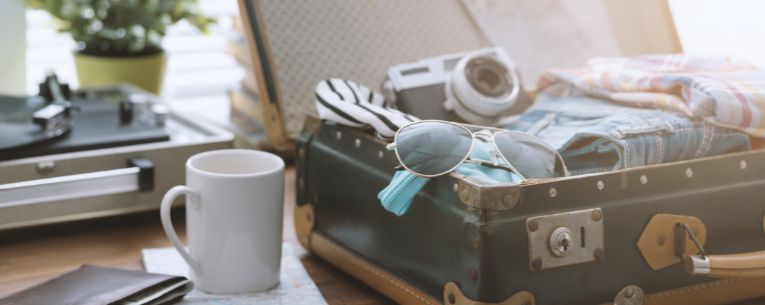In 2021, the Transportation Security Administration confiscated 5,972 firearms at security checkpoints—not to mention a cleaver, a can of bear spray, and a chainsaw.1, 2
You, of course, are a savvy traveler who would never pack such hazardous items in your carry-on bag. But what about in your checked bag? What’s allowed by the TSA, and what’s prohibited?
The answers aren’t always intuitive. For instance, you can pack your cleaver. You may be able to pack your chainsaw, as long as it’s purged of fuel and the airline permits it. But bear spray? No way.
Wondering, “What can I pack in my checked luggage?” Here are some of the most common prohibited items.
Items that are not allowed in checked luggage
Aerosols (in most cases)
Aerosol sprays are only allowed if they’re for medicinal or toiletry use (such as insect repellent or hairspray). They must be capped securely. Other aerosols—such as spray paint, air freshener or cooking spray—are not allowed.3
Any device containing lithium metal or lithium-ion batteries
If lithium batteries are damaged, or if the terminals are short-circuited, they can catch fire. For this reason, airlines prohibit them in checked bags; if a lithium battery fire occurs in the plane cabin, flight attendants can respond, but a fire in the cargo hold is a major problem.
You might think, “Oh, I don’t have any lithium batteries,” but they’re found in many common electronic devices, such as:
- Laptops
- Smartphones
- Tablets
- Portable chargers
- Cameras
- Drones
- Vape pens
- Lighters4
Bug spray
While you are permitted to bring insect repellent that’s applied to skin, you can’t pack any bug spray that’s sprayed into the air or at insects.
Christmas crackers
These traditional British party favors are cardboard tubes that snap when you pull them apart, revealing a small trinket and a paper hat. While seemingly harmless, they’re not allowed on airplanes because they contain a tiny amount of gunpowder.
Compressed gases
Oxygen tanks, SCUBA tanks, butane, propane and other compressed or flammable gases are not allowed in checked or carry-on baggage. If you require oxygen, you must carry a portable oxygen concentrator or ask your airline to provide oxygen service.5
Corrosive or oxidizing chemicals
If a chemical could be considered a hazardous material (hazmat), don’t put it in your luggage. Examples include chlorine, strong acids, paint stripper, drain cleaner, etc. Even hair dye can fall into this category.
Cremated remains
While the TSA doesn’t generally prohibit carrying cremated remains in checked luggage, some airlines do. It may be better to bring them in your carry-on luggage in a lightweight container that can be easily screened. “Out of respect for the deceased, TSA officers will not open a container, even if requested by the passenger,” the agency says.6
Emergency Position-Indicating Radio Beacons
These nifty devices are intended to save your life if you’re lost in the wilderness or at sea by sending your location to emergency responders. Are EPIRBs allowed on planes? The TSA says to check with your airline.7
Extra-strong spirits
Beverages containing more than 70% alcohol (over 140 proof), including grain alcohol and 151-proof rum, are not allowed in checked or carry-on baggage.
Firearms
Guns are not allowed in your checked luggage unless they’re unloaded, packed in a locked hard-sided container, and declared to the airline at check-in. Always check with your airline about their policy on firearms, and carefully read (and follow!) the rules about transporting firearms on planes.
Fireworks
It’s not only large fireworks that are prohibited, but also the small ones: sparklers, poppers, bang snaps, etc.
Hazmats
You are generally not allowed to bring any hazardous materials onto an aircraft, including (but not limited to) radioactive materials, poisonous or toxic substances, or flammable liquids.
Live fish or coral
These should be transported in a transparent container of water in your carry-on baggage. Live lobsters, on the other hand, may be packed in checked luggage. From the TSA: “We recommend that you contact your airline to determine your airline's policy on traveling with your lobster before arriving at the airport.”8
Matches
You can bring a single book of safety matches in your carry-on, but no matches can be in checked bags.9
Medical marijuana
Regardless of your state’s (or your destination’s) policies on medical marijuana use, it remains illegal under federal law. The exception is products that contain no more than 0.3 percent THC on a dry weight basis or that are approved by the FDA.10
Mercury thermometer or barometer
Unless you work for a government weather agency, you can’t bring these in your checked bags.11
Paint
Spray paint and any flammable kind of paint, or paint thinner, are not allowed in your checked bags. Most artist’s paints are nonflammable, so they’re OK.12
Replicas of explosive/incendiary devices
It doesn’t matter if they’re fake, or children’s toys: Realistic replicas of bombs, grenades, etc. are definitely not allowed in checked or carry-on bags. Replica firearms are OK in checked bags.
Tear gas
While a small (4 oz. or less) container of pepper spray is permitted in checked baggage (as long as it has a safety feature to prevent accidental discharge), self-defense sprays containing more than 2% by mass of tear gas are prohibited.13
Torch lighters
These specialty lighters, which emit a high-temperature jet of flame, are not allowed on airplanes.14
This list isn’t exhaustive, so check the TSA’s “What Can I Bring?” database before you fly. Have a question about a specific item? You can send a picture or a question to AskTSA on Facebook Messenger or Twitter.
Also, be aware that these TSA prohibitions apply specifically to domestic flights. If you’re flying internationally, additional rules may apply.
Items you shouldn’t pack in your checked luggage
Some things, while they’re allowed in your checked bags, are better stowed in your carry-on. The best rule of thumb is that anything necessary, valuable or important to you should be kept with you. This includes:
- Prescription medications
- Passports and travel documents
- Electronics, such as video game systems and computers
- Cameras (camera film, including Polaroid film, should be hand-checked by TSA agents so it doesn’t go through the X-ray machine)
- Jewelry and other valuable items
- Irreplaceable clothing, such as a wedding dress
- Cherished items, such as stuffed animals or family photos
- Medical or personal items that are difficult to replace
If your bags do go missing, travel insurance can help. Your baggage loss/damage benefit can reimburse you for the actual price, actual cash value, repair or replacement (whichever is less) of your missing or damaged items, up to the limit in your plan.
When filing a claim, provide receipts, if possible. (For items without an original receipt, your baggage loss/damage benefits can cover up to 75 percent of the actual cash value of your possessions.) Take a photo of your suitcase when you’re packing, so you have proof of what was inside. And read your travel insurance plan so you understand what’s excluded from coverage. Examples include hearing aids, eyeglasses, wheelchairs, firearms, perfume and cosmetics.
Find yourself facing a lost-luggage emergency? Contact 24-hour assistance. Our travel experts will do their best to help.
*This summary was generated by AI with the oversight of our author.








Share this Page